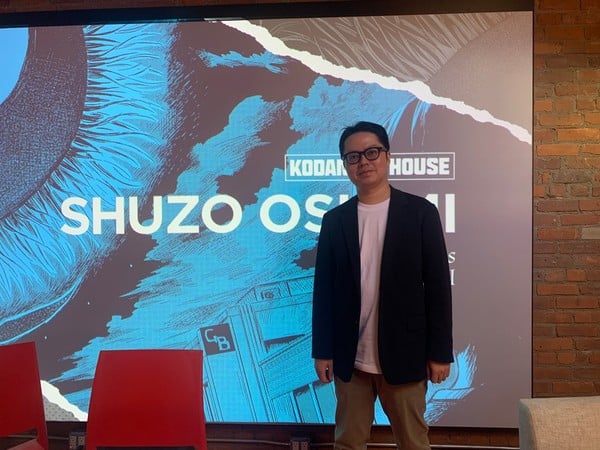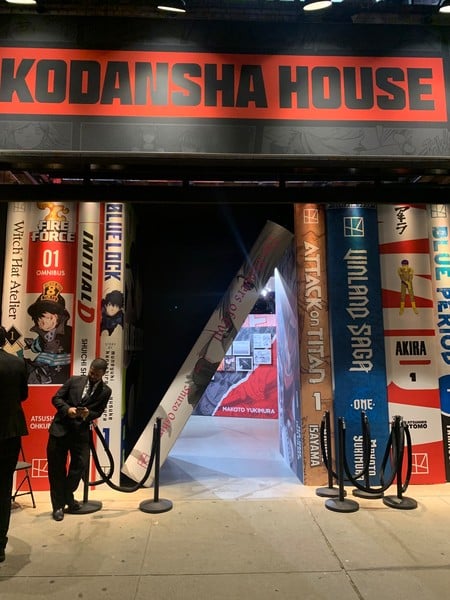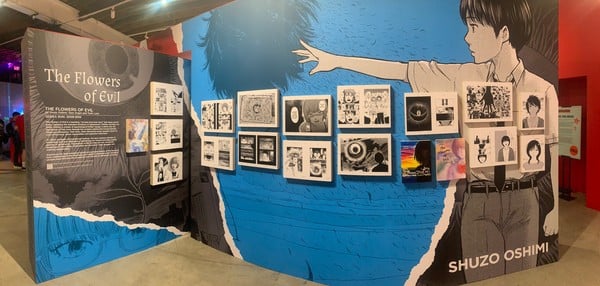Blood on the Tracks Manga Creator Shūzō Oshimi Can't Help But Get Personal
by Reuben Baron,“Have you ever read a comic that crept up on you? A story that lingers long after you put the book down? You turn off the lights and get ready to sleep, and then, from the darkness, this story reaches out and grabs your ankle? Congratulations, you've just read a comic by Shūzō Oshimi.” This is how comic creator Becky Cloonan introduced Shūzō Oshimi during his October 4 visit to the Kodansha House pop-up in New York City.

The final volumes of Oshimi's concurrent series, the unnerving bad parenting thriller Blood on the Tracks and the gender-questioning romantic drama Welcome Back, Alice, recently came out in the U.S. Readers were excited to get their books autographed by the author at his first-ever international fan event. Before the signing, Oshimi partook in a panel discussion with Cloonan (Oshimi illustrated a cover for the third issue of Cloonan's horror series Somna).
Oshimi and Cloonan discussed inspirations (GeGeGe no Kitarō got Oshimi into drawing manga as a kid, while Daniel Clowes' Ghost World was a major inspiration as an adult), deadlines (he had a lot of them writing two manga at once!), torturing characters (Oshimi explained his main characters are “projections of myself,” to which Cloonan responded, “You need to be nicer to yourself”), planning out long-form stories (Oshimi knew the climax of Blood on the Tracks in advance, but not the ending), and the trauma of growing up (“It's not like I was afraid of growing up, but I just didn't have the confidence to continue to live this way” — Oshimi feels he's finally overcoming these feelings of anxiety by expressing them in his work).
Fans asked which of Oshimi's characters he relates to the most (Kasuga from Flowers of Evil and Seiichi from Blood on the Tracks — particularly the latter's struggles with romantic relationships), who “Alice” is in the title Welcome Back, Alice (the name doesn't refer to any of the story's characters, but instead “represents a part of me that I lost”), and why Oshimi writes so much about masturbation (he says, “it's the only way I can rebel,” and “[it's] kind of a rebellion towards my parents”).
ANN got the chance to speak with Oshimi one-on-one to find out more about how he makes such creepy and deeply personal manga and what topics we can expect him to explore more in the future.

Blood on the Tracks impressed me with how much tension was built into every moment, even at points when there was very little happening. How do you maintain such an intense atmosphere in such a slowly-moving narrative?
OSHIMI: When I started to draw Blood on the Tracks, I decided to draw strictly from the main character's perspective, so what you see in the manga is through the lens of the main character. In my attempt to show his perspective, sometimes I try to express him experiencing tunnel vision; sometimes he goes through a blank-out, and the slowed-down pacing is also a part of his experience. I'm really glad that it is actually conveyed to the readers.
What qualities were important to you when writing the character of Seiko, the mother in Blood on the Tracks?
OSHIMI: Even the illustration of Seiko, when I draw that character, is also drawn from how Seiichi, the main character, sees his own mother. I really wanted to express his vision in the art. I decided to try to draw her as beautifully as possible, as if it's almost scary.
Much of your work deals heavily with gender issues. What keeps bringing you back to new explorations of these themes?
OSHIMI: That comes from my own experience of having some ambiguity about my own gender, and I wanted to express that in my work.
Many of your series are published in shonen magazines, even while dealing with very heavy subject matter some might consider "adult." How do you target your approach in addressing topics of sexuality and psychological horror when writing for a shonen audience vs. a seinen one?
OSHIMI: Usually, whenever I draw a manga, I have this audience in mind, which was myself when I was 14. I hope that whenever a 14-year-old reader reads my work, I help them realize there's a world outside of what they were told is the world. So I'm always paying attention to whether manga can have that role, and I aspire to make works that would have an impact on somebody's life.
Kodansha will bring your new manga Toxic Daughter: Chi-chan to America next year. What do you want American fans to know about it? I know it's a prequel to a film [Doku Musume], but can it be enjoyed on its own without having to see the film afterward?
OSHIMI: At first, I was involved in this movie as a character designer. Almost as a part of the process, I thought of the prequel story; the story that takes place before the movie. Because of this, I think you can enjoy the manga first before you watch the movie, but if you read the manga and watch the movie, you'll probably have a better understanding of each character. Actually, the only overlap between the manga and the movie is this character named Chi-chan, and other than that, there is not much connection, so therefore, it can be enjoyed as a stand-alone.

The Flowers of Evil manga is 15 years old this year. Looking back on the series compared to your current work, what has changed for you as an artist?
OSHIMI: Flowers of Evil is the first manga where I felt I was able to fully express myself. From what I learned from Flowers of Evil, I continued to deepen the direction in other series. The deepest I went, I think, was Blood on the Tracks. I don't know if I could call that my personal growth, but at least I can say my [artistic] expression has more depth now.
You get extremely open about a lot of personal topics in your manga, especially in the afterwords of manga like Welcome Back, Alice. Does this openness come naturally to you, or is it difficult to get so personal?
OSHIMI: When I started to draw manga, I wasn't sure people would like my work, so I was working with that doubt in my mind. I always wanted to express it anyway. Those feelings I wanted to express through manga finally came true in Flowers of Evil, and so many readers also accepted it. I felt like that was a very satisfying feeling to be understood. Ever since then, I cannot live without that kind of feeling.
This is your first fan event in America. What's that experience been like for you?
OSHIMI: This is a really important and very happy time of my life. I've been welcomed so warmly by so many people. I realized that the stories and manga I've been working on all my life have been understood universally.
What sort of manga are you planning on working on next?
OSHIMI: I haven't made any official announcements, but I certainly do have a new idea for my next project. Actually, after I finished Blood on the Tracks and Welcome Back, Alice, I honestly felt like I had nothing left to write about. As for the theme of the next work that I have in my mind, it's not too crystalized just yet. However, I have this idea to expand upon what I have been discussing in the afterwords [of my manga].
discuss this in the forum (3 posts) |
this article has been modified since it was originally posted; see change history